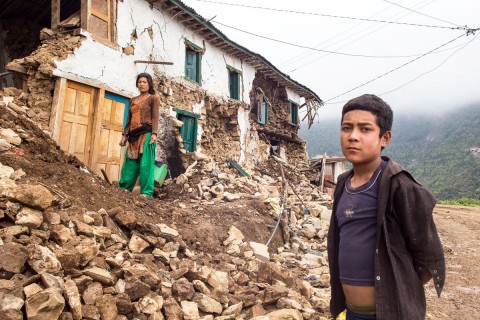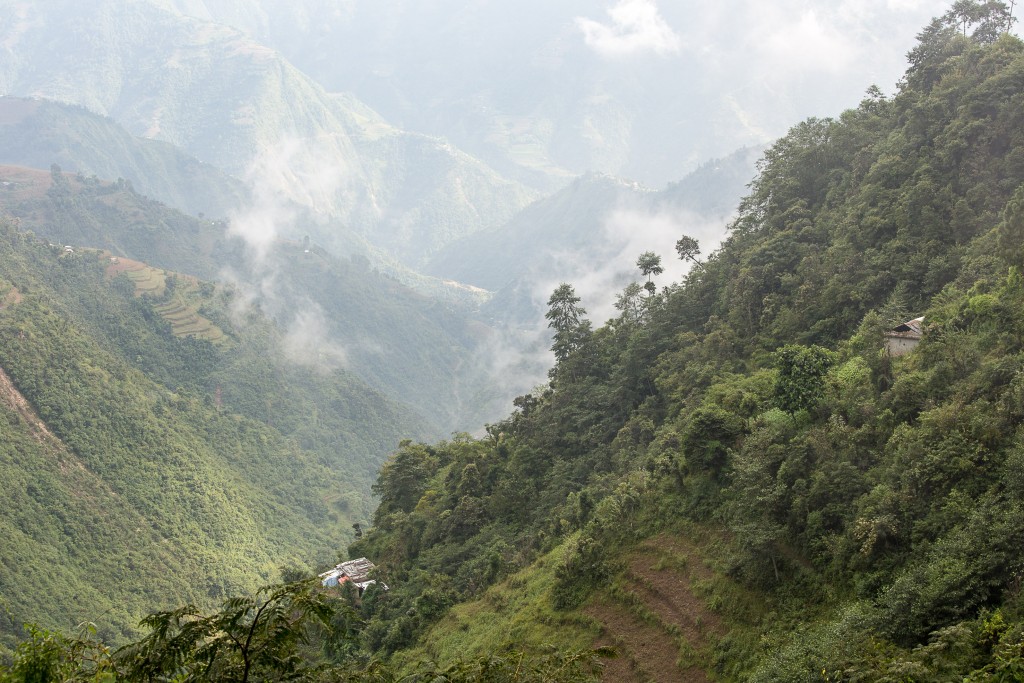Visit to the Women’s Bank’s village in Nepal five months after the earthquake
The Nepalese village of Bhattendada, which is supported by the Women’s Bank, suffered heavily from the April earthquake. We visited the village five months after the earthquake to see how the people have been coping.
Text and photos: Antti Helin
The clouds roll over Bhattendada like a bright thin veil. The village sits at an altitude of two kilometres on the mountains surrounding Nepal’s capital city Kathmandu.
A women’s cooperative supported by the Women’s Bank in cooperation with Finn Church Aid (FCA) is operating in the village.
I first visited Bhattendada in early May, right after the Nepal earthquake. The village had suffered a lot.
Almost all of the little over 400 houses in the village had collapsed or become inhabitable due to damage. Landslides had buried farming patches and most of the cattle had died.
26-year-old Sangita Thing sat desolate on the ruins of her home. Her house had collapsed and she had lost three buffalos and cows. Thing was holding two squashed metal cans in her hands.
“I have nothing left”, she mused with grief. All of her few possessions had been buried in the ruins of her home.
Smiles and worries
Now, at the end of September, the village is barely recognisable. The ruins of the two-storey, blue and white houses have been cleared off.
Instead, the village is full of low huts made from corrugated iron sheets.
The change is evident on the faces of the villagers too. I meet Sangita Thing on the muddy main street. She’s smiling.
“The first time I felt happy was three months after the earthquake when we finished our temporary shelter”, Thing says.
Thing explains how she gathered the corrugated iron sheets from multiple sources. “Some of the sheets are from my old house, some I bought and some were donations from organisations. We helped one another with the building.”
Thing’s family has received 15,000 rupees (about 125 euros) from the Nepalese government to rebuild her house. That money has been spent on the temporary hut.
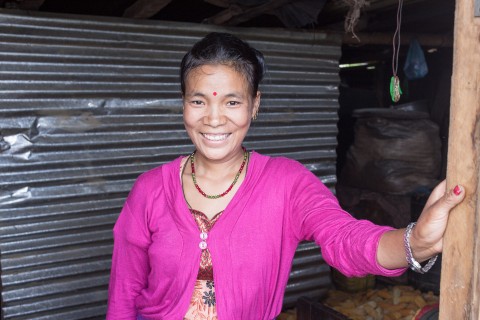
Smile has found its way back on the face of Sangita Thing, even though life after the earthquake is still difficult. Thing says she has received a small loan from the local cooperative, supported by the Women’s Bank, and with it she will replace her destroyed vegetable plantation.
The Nepalese government has promised to support those who have lost their homes by 200,000 rupees (about 1,500 euros), but nobody knows when the funds will be released or if they’ll be released at all.
Thing opens the door to her small hut. The floor is covered with drying corncobs; there is no room for them anywhere else. She has kept what little possessions she was able to salvage from the ruin.
A temporary shelter is not a long term solution. The cramped hut houses six people. But a lack of space is not the only problem of a hut made out of corrugated iron sheets.
“The days are hot and the nights are cold. When it rains heavily, water comes in”, Thing explains. And winter is coming. Between December and February, nightly temperatures in the mountains fall close to zero.
Thing had just repaid a loan she received to rebuild her house, when the house was destroyed in the earthquake.
Now she has taken a new loan of 10,000 rupees (about 85 euros) from the Women’s Bank cooperative and plans to use it on setting up a vegetable farm she lost in the earthquake.
Making a living is not easy. The three of Thing’s buffalos that survived the earthquake have stopped producing milk. Thing does not know why.
The earthquake must have shocked the animals like it did the people.
Thing’s smile masks enormous difficulties the villagers are still facing.
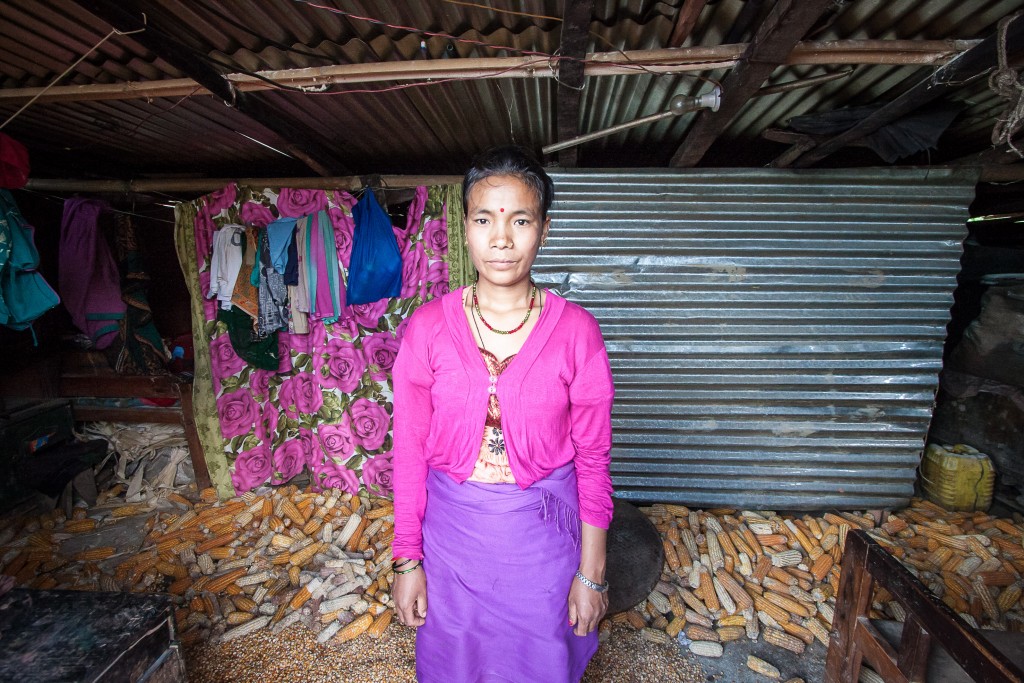
Sangita Thing is drying her corn crop on the floor of her home because there is no room anywhere else.
Sabita Muktan is still afraid
Another woman I met in Bhattendada after the earthquake was 24-year-old Sabita Muktan. Her house, too, had collapsed and she was deeply shocked by the disaster.
“My heart is still racing”, Muktan described her feelings a week after the earthquake.
Fear of a new earthquake has subsided but not disappeared. “I am still afraid, but not as much”, Muktan says. Her eldest son is still afraid too.
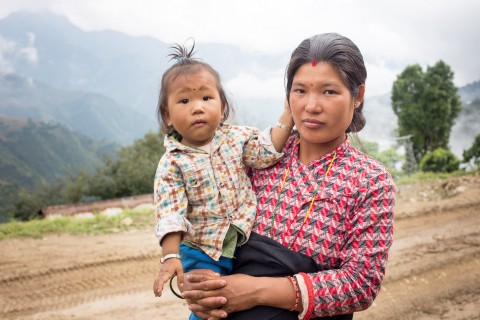
Sabita Muktan is expecting her third child in the middle of the havoc left by the Nepal earthquake. She is holding 18-month-old Raj Muktan. “My situation is not easy”, she says.
“My seven year old son would still not want to sleep indoors. Fortunately, my younger son doesn’t understand the situation.”
Muktan, 24, shares a dim little hut with her husband, their two children and her mother and grandmother.
The family is also growing. Muktan’s belly has grown since the last time we saw her, her pregnancy is on its final stages.
“The difference is that now we have these temporary shelters. Other issues are still pressing”, Muktan summarises the situation in the village.
Muktan hopes to rebuild her home but she has no idea when that will be possible. The most acute concern is feeding her family.
A large part of the family’s corn crops are destroyed, a situation very common among the people in the village. The family’s small farm fed them for five months a year and the rest of the time they made do with simple paying jobs.
The remaining crops will only produce enough food to feed the family for one month. At the same time, the chances of finding employment have become poor. Before the earthquake, Sabita Muktan had been studying to become a seamstress in a vocational training organised by the Women’s Bank. She had even purchased a sowing machine with a loan from the cooperative supported by the Women’s Bank.
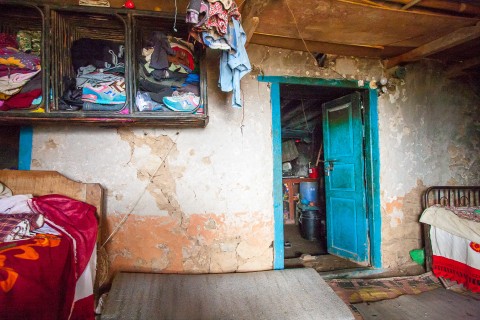
Part of the a cracked wall of Muktan’s family’s old house serves as a wall in their hut. The hut is home to six people.
But since the earthquake, she has not been able to work at all. First the family lived in a tent where there was no room to use the sowing machine, and now her pregnancy has advanced so far it is impossible to work.
Muktan’s husband is disabled, and cooks meals for the workers repairing the mountain road passing through the village. He works for food.
Immediately after the earthquake, Muktan and the other villagers were given rice by aid organisations as emergency assistance, but food distribution has been stopped.
“We received 60 kilos of rice in assistance. Afterwards, I have bought 30 kilos more using my meagre savings and I should buy more again. I’ve run out of money”, Sabita Muktan’s 54-year-old mother Rita Muktan says.
“Where are we going to get the money? What should we do?”
The cooperative is a safety net
Muktan’s family, like many other people in the village, has been forced to live on loans. The cooperative supported by the Women’s Bank is the first Place members go to apply for a loan.
Loans are hard to get from anywhere else, at least on decent terms, because the poor villagers have nothing to offer as collateral.
The cooperative has been faced with a tough challenge as the need for loans is bigger than ever.
In principle, you can only get a new loan once your old one is repaid in full. Sabita Muktan still has half of her previous debt left. She says, however, that the rules are flexible when the needs are this urgent.
For Sabita Muktan, the cooperative might be the last safety net. She says her baby is due in five weeks, into the winter in Nepal.
“It is going to be very cold then. Our situation is not easy”, she says.
